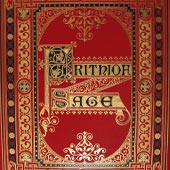Cabinet 13: Alternative Uses of Initials in Books

Contents page
Enlarged initials can be used to great effect in sections other than in the main text of a printed work, such as on contents pages. The destinations in Charles Patin's Travels thro' Germany are grouped alphabetically. An enlarged initial has been applied to the first destination in each group. The effect is both eye-catching and functional with the enlarged initials serving as a finding aid.
Charles Patin, Travels thro' Germany, Bohemia, Swisserland, Holland, and other parts of Europe: describing the most considerable citys, and the palaces of princes, together with historical relations and critical observations upon ancient medals and inscriptions. London, Printed for A. Swall and T. Child ..., 1697. DeBeer Eb 1697 P

Book Covers
Book covers also provide an opportunity to use initials as embellishments. On display is a copy of Esaias Tegner's Frithiofsage. In keeping with the manuscript tradition, the first initial 'F' has been decorated with a sense of it being a major initial – at least 4 lines high and very ornate, while the 'S', being very much shorter and less ornate, shows the characteristics of a minor initial. The bold use of colours enhances both the decorated initials and the ornate borders.
Esaias Tegner, Esaias Tegners Frithiofsage. Munchen : Verlagsanstalt fur Kunst und Wissenschaft, [18--?]. Special+ PT9831.G5 CJ19

Text as initials
The Alphabet Book contains 30 pages, each illustrated with a large decorative letter from A to Z. The content of this book is solely decorated letters. The colophon states that "each letter began as an original papercut and was photo-engraved for the printing of the book." The H on display appears to be a modern interpretation of a floriated initial.

